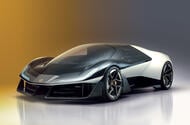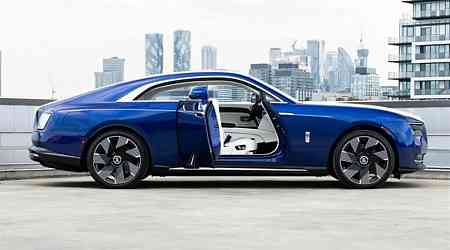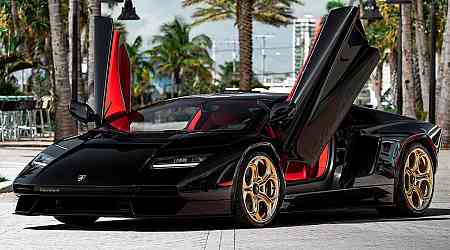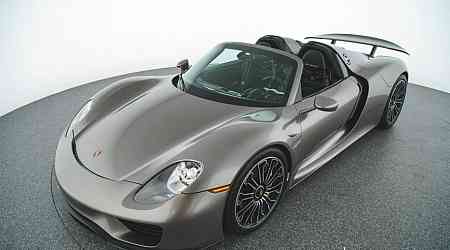The Theory 1 boasts a claimed 0-62mph time of less than 2.5sec and a top speed of 199mphTheory 1 concept draws on Esprit’s ethos to pack 986bhp electric punch
The radical new Lotus Theory 1 concept is a three-seat, 986bhp supercar designed to evoke the spirit of the Esprit as a brand-building performance showcase that will be a “blueprint” for all of the firm’s future cars.
The new supercar uses a twin-motor all-wheel-drive electric powertrain that draws energy from a 70kWh battery mounted next to the rear motor in the lightweight carbonfibre tub.
It has a claimed 0-62mph time of less than 2.5sec and a top speed of 199mph. The Theory 1 displays subtle styling nods to the Series 1 Esprit, but the link is more in the ethos of the project.
The Theory 1 displays subtle styling nods to the Series 1 Esprit, but the link is more in the ethos of the project. “When the Esprit launched, it was a superbold expression of futurism,” said Lotus chief creative officer Ben Payne.
“We’re taking that ideology and trying to work out what it means today.” While the Theory 1 is officially a concept – which explains why it doesn’t have a Lotus Type number – Payne said around 85% of its technical features are production-ready, and he hinted that a road-going version could follow.
“We create these things to gauge public reaction, so we will listen to what people say,” he said. “There are elements of it that you will see quickly in other vehicles and parts that will inform many other things.”
Lotus Theory 1 design and styling
Lotus kick-started its electric reinvention under Geely ownership with the 2011bhp Evija hypercar, which was followed by the Eletre SUV and the Emeya saloon, with a smaller SUV due to follow.
The Theory 1 showcases the fi rm’s vision for the next wave of vehicles – and it is purposefully positioned as a supercar rather than a hypercar.
“It’s high performance, but not the ultimate extreme end of it,” said Payne. “It’s about a balanced proposition with a fantastic car and a great user experience, which can give some real direct translation of our core brand back into an electric performance vehicle.”
The concept showcases Lotus’s new ‘design manifesto’, termed DNA, for ‘Digital, Natural and Analogue’. The approach is based around the use of intelligent technology and performance engineering to develop driver-focused cars.
Styling for the Theory 1 was led by the team at Lotus’s design centre in Coventry, and the concept sits on a bespoke platform. The Theory 1 is 4490mm long and just 1140mm tall, with a 2650mm wheelbase.
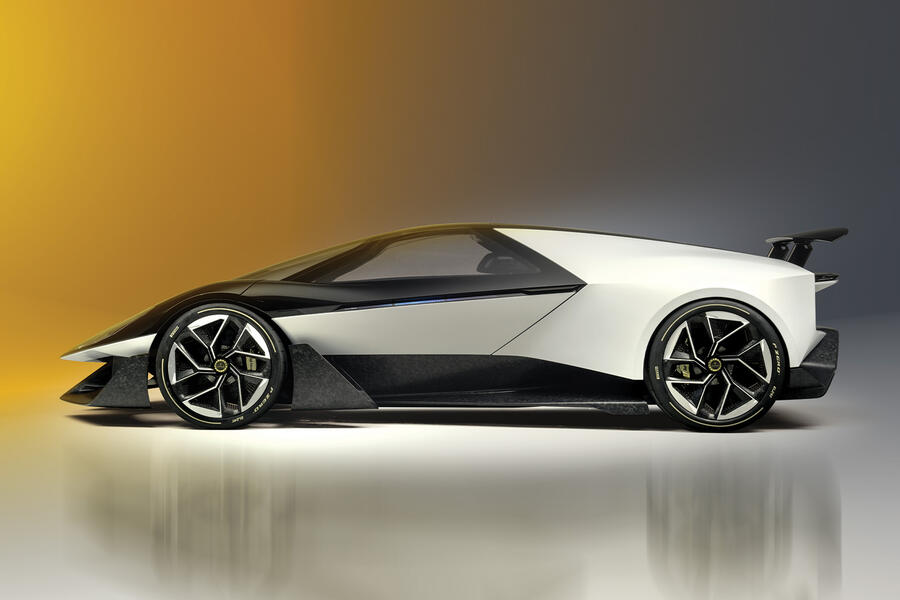
Payne said the design and engineering teams worked together closely to “balance creating something that was aesthetically pleasing and functionally correct”.
The car is in effect split into two sections, with a heavily sculpted lower tub in exposed carbonfi bre topped by a white body that merges into a large glass dome roof.
Engineer Phil Hall said: “Really, there’s a singleseater race car structure underneath, in terms of the structure, suspension and aerodynamics, but with a nice dress on top to make it more approachable as an everyday road car proposition.”
The front end features a diffuser and drag-reducing air deflectors, which are designed to create an air curtain to reduce wake. That works in conjunction with a sculpted underside that directs air into the cooling system before being directed to reduce drag and optimise the downforce of the adjustable rear wing.
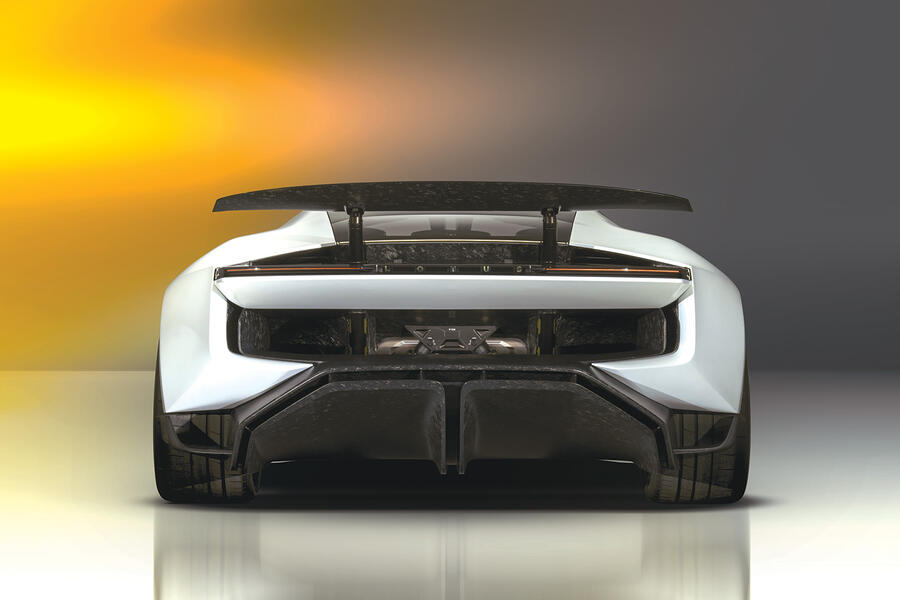
Despite the emphasis on aerodynamics, style was an important consideration. Exterior design lead Amar Vaya called it “an expression of art and engineering”. He added: “We are putting a functional object on the road, but we wanted to keep the artistic element alive.”
Notably, the Theory 1 has been designed so that much of the running gear is visible, either through the minimal bodywork or via a large recycled-glass greenhouse. Payne said that was done “so you can look through and see both the mechanical and the design aspects”.
The Theory 1’s minimal bodywork was also a nod to former Lotus boss Colin Chapman’s lightweight ethos. Vaya said: “There are a lot of ways you can interpret lightness. It’s not just reducing mass. Chapman once said ‘there’s nothing lighter than a hole’ and you can see that philosophy here.”
The lower and upper sections of the body are split by a prominent line that nods to the seam on the Esprit S1, but in this case it features an OLED strip that can be used to communicate with other road users.
Lotus Theory 1 engineering and performance
The 986bhp powertrain features a 690bhp rear electric motor as the main drive unit, with a 296bhp electric motor on the front axle. Placing the smaller motor at the front meant “you don’t need a big, bluff front end,” said Hall.
The 70kWh battery pack is built around the rear motor, giving the car a similar weight balance to that of rear-engined supercars and allowing it to sit low to the road.
The rear motor and battery assembly are used as a stressed member, with the rear suspension and wing attached directly to it – aping an F1 design trend started by the 1967 Lotus 49.
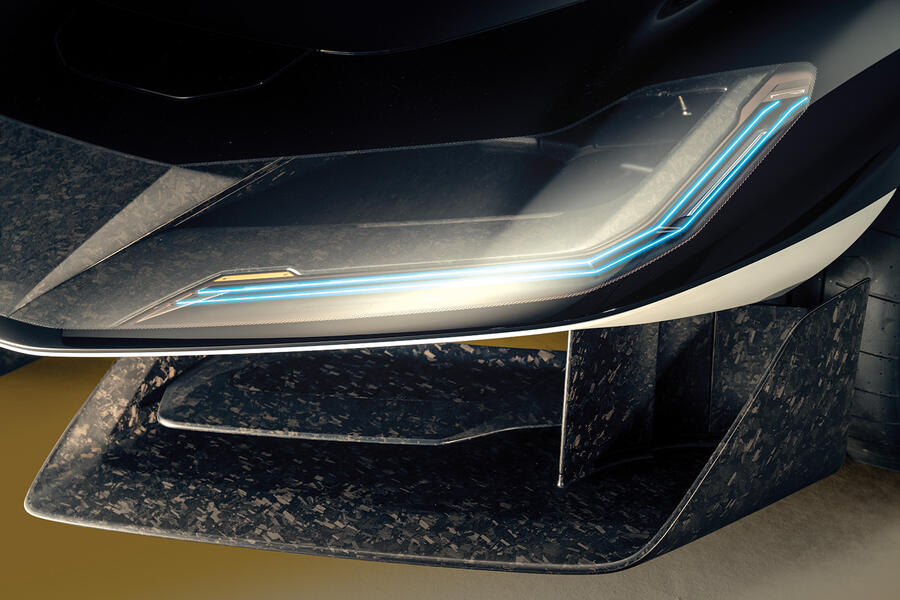
“There’s a great historical link and it enables us to make the package really small,” said Hall. The Theory 1 is claimed to weigh less than 1600kg, which would make it nearly 300kg lighter than the Evija.
Much of the other running gear of the car comes from proven partners: AP Racing, which worked with Lotus’s F1 team on the 49, provides the six-piston caliper brakes, while the car sits on Pirelli P Zero Elect tyres.
The wheels are 20in front and 21in rear. There is steer-by-wire technology and doublewishbone suspension at both ends of the car.
Lotus Theory 1 interior design
The Theory 1 adopts a similar three-seat layout to that of the McLaren F1, with the driver positioned forward and centrally, and the two passengers slightly behind on either side.
In a bid to improve sustainability, Lotus designers aimed to use only 10 ‘A-surface’ (visible) materials, compared with around 100 in an average car.
One key element of that was leaving much of the interior bare to showcase the recycled chopped carbonfibre tub, and the seats are sculpted directly into that. In another nod to Lotus’s F1 heritage, the key functional components both inside and outside the car are coloured gold.
There is only minimal padding for the seats. Interior design chief Ben Hall said: “We looked at pressure maps of how people sit in our current cars to define the minimum requirements and ensure they had sufficient support.”
Because the driver’s seat is fixed, the steering wheel and pedals automatically retract and extend to fit the driver. The minimalist interior goes without an infotainment screen or traditional display. There is a small screen on the steering wheel, and the speedometer sits under the lip of the windscreen, within the driver’s eyeline.
The car also uses new technology to minimise functions. OLED lights can signal when to turn, while a system called Lotuswear, developed with start-up Motorskins, features small inflatable pads in the seat and steering wheel that can offer haptic feedback prompts.

For example, instead of a warning light when a car is in a driver’s blindspot, the system could replicate a tap on the driver’s shoulder. The focus was on maximising visibility and making the interior feel open.
Payne noted that the low windscreen and raised wheel arches give the driver a clear sight of where the wheels are located, known in Lotus as the ‘Becker line’ in a nod to former dynamics guru Matt Becker.

Ben Hall said the low, central driving position is good for dynamics, “because it puts you at the centre of the yaw for the vehicle, so you’re fully in contact with the front and back of the car”.
He added: “We’re doing this to explore the brand, but there’s also going to be a real market need at some point. This is a theory, so we have to be mindful of those customer experiences. Space and time are luxuries these days. We’re not saying this is a luxury experience; it’s a different message, but those are elements people hold dear.”
What's next for Lotus?
While the Theory 1 is officially a concept, many of its ideas are likely to feature in the Elise-replacing Type 135 sports car due in 2026, which is being developed at Lotus’s Hethel site. But questions remain over that programme, with doubts about the future of the Norfolk facility.
Before then, Lotus will launch the Type 134 electric SUV, a sub-Eletre model that’s due next year and could feature design cues influenced by the Theory 1.
Lotus posted losses of £332 million in the first half of this year and recently slashed its sales targets due to 100% tariffs imposed on Chinese-built EVs in the US. There have also been a number of job cuts.




















